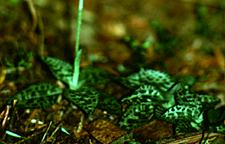Goodyera repens (L.) R. Brown var. ophioides Fern.
Lesser rattlesnake plantain
The specific epithet repens is the Latin meaning "creeping,"
and refers to the spreading rhizomes. The varietal name ophioides
is the Greek meaning "snake-like."


DESCRIPTION: Plant pubescent
above the leaves, 6-15(-20) cm tall (including inflorescence), arising from
a rhizome supported by a cluster of slightly fleshy, fibrous roots. Leaves
4-7, forming a basal rosette, short-petiolate, ovate, 1.5-4 cm long and
0.5-2 cm wide, dark green or blue-green with a +/- prominent network of
reticulate silvery markings. Inflorescence a downy, dense to lax,
spicate, secund raceme 6-15(-20) cm tall, 8-20 flowered, each flower subtended
by a small, lanceolate bract. Sepals ovate to elliptical, concave,
3-4.5 mm long and 1-2.5 mm wide, white and smooth inside, the outer surfaces
pubescent, lateral sepals typically smaller than dorsal sepal and slightly
spreading; dorsal sepal connivent with petals to form a hood over the column.
Petals oblong or spatulate, 3-4.5 mm long and about 1-2 mm wide,
closely appressed to the dorsal sepal, white. Labellum globular-saccate,
the apex prolonged into an blunt point (looking somewhat like a spout),
2.5-4 mm long and about 2 mm wide, white.
SIMILAR SPECIES: Goodyera repens var. ophioides can easily
be confused with G. tesselata or perhaps
G. pubescens . G. repens var.
ophioides can be separated from G. tesselata
by overall size, with G. repens var. ophioides being generally
smaller. Distinguishing between these two taxa can be very difficult, however.
This problem is exacerbated by the fact that G.
tesselata frequently hybridizes with G. repens var. ophioides.
G. repens var. ophioides can be separated from G.
pubescens by the inflorescence, which is secund or loosely spiraled
in G. repens var. ophioides, but is a cylindrical, densely-packed
spike in G. pubescens.
HABITAT: Typically found in coniferous bogs, particularly under Thuja,
but also found in damp woods and rarely drier woods. I have found Goodyera
repens var. ophioides growing under Thuja on a dryish
dolomite outcrop in the upper peninsula of Michigan, not far from the Wisconsin.
It may occupy similar habitat occasionally in Wisconsin.
FLOWERING DATES: July 15-August 25.
POLLINATION: According to Kallunki (1981),
bumblebees pollinate G. repens var. ophioides.
DISCUSSION: This species is involved with Goodyera oblongifolia
in the hybridogenic origin of G. tesselata. For a detailed discussion
of this, see Kallunki (1976). Our variety
ophioides is distinguished from variety repens by the venation,
which is prominent in variety ophioides and absent in variety repens.
WI DISTRIBUTION:  U.S. DISTRIBUTION:
U.S. DISTRIBUTION:
Go directly to Wisconsin herbarium records.
Return
to the main LIST of the Orchids of Wisconsin.
Return to the main KEY to the Orchids of
Wisconsin.


 U.S. DISTRIBUTION:
U.S. DISTRIBUTION: